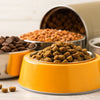What is a Good Dry Dog Food? A Comprehensive Guide for Pet Owners
- Houndsy
Table of Contents
- Introduction
- Understanding Dog Nutritional Needs
- What to Look for in Good Dry Dog Food
- What to Avoid in Dry Dog Food
- Special Dietary Needs
- The Role of Houndsy in Enhancing the Feeding Experience
- Conclusion
- FAQs
Introduction
Did you know that nearly 60% of pet owners struggle with dog food choices, often overwhelmed by the sheer variety of options available? For many of us, the dog's diet is a top priority, but with conflicting advice and countless brands vying for our attention, it can feel like navigating a maze. The significance of choosing the right dry dog food cannot be overstated; a well-balanced diet contributes not only to our dogs' physical health but also to their overall happiness and energy levels.
In this blog post, we will explore what constitutes good dry dog food, highlighting essential ingredients, nutritional needs, and how to make informed decisions as responsible pet owners. By the end of our discussion, you will have a clear understanding of what to look for in quality kibble and how our flagship product, the Houndsy Kibble Dispenser, can enhance your feeding routine, providing convenience and consistency in your dog’s diet.
We will cover various topics, including essential nutrients, what to avoid in dog food, specific dietary needs based on breed and age, and tips for selecting the best dry dog food for your furry friend. We’ll also touch on how our design philosophy at Houndsy aligns with ensuring your dog receives the best nutrition while making feeding a joy rather than a chore.
Understanding Dog Nutritional Needs
Essential Nutrients for Dogs
Just like us, dogs require a balanced diet rich in nutrients to thrive. Here’s a breakdown of the essential nutrients that should be included in your dog’s dry food:
- Proteins: Proteins are the building blocks of your dog's body, essential for growth, maintenance, and repair of tissues. High-quality sources of protein in dry food include chicken, beef, fish, and lamb.
- Fats: Healthy fats are crucial for energy, skin health, and nutrient absorption. Look for sources like chicken fat or fish oil in dog food that provide omega fatty acids.
- Carbohydrates: While not essential in the same way proteins and fats are, carbohydrates provide energy and support digestive health. Ingredients like brown rice, oats, and sweet potatoes are good options.
- Vitamins and Minerals: Micronutrients are vital for various bodily functions. Ensure your dog’s food is enriched with vitamins A, D, E, K, and B-complex as well as essential minerals like calcium and phosphorus.
- Water: Although not a part of dry food, always ensure your dog has access to fresh water. Hydration is crucial for overall health.
Tailoring Nutritional Needs by Life Stage
Different life stages require different nutritional profiles. Puppies, adults, and senior dogs have distinct needs:
- Puppies require higher protein and fat levels to support growth and development.
- Adult dogs need a balanced diet that maintains health without leading to obesity.
- Senior dogs may require lower calories and additional joint support, often found in formulas enriched with glucosamine and chondroitin.
What to Look for in Good Dry Dog Food
Ingredient Quality
The first step in choosing a good dry dog food is evaluating the ingredient list. High-quality dog food typically features whole foods and recognizable ingredients. Here are some tips for assessing ingredient quality:
- Meat as the first ingredient: Look for formulas that list real meat (e.g., chicken, beef, lamb) as the first ingredient. This indicates a higher protein content, which is vital for your dog’s health.
- Whole grains and vegetables: Ingredients like brown rice, sweet potatoes, and peas are excellent sources of carbohydrates and fiber.
- Avoid fillers and by-products: Steer clear of foods that have vague terms like "meat meal" or "by-products," as these can include low-quality animal parts and fillers that provide little nutritional value.
Nutritional Adequacy Statement
Check for the AAFCO (Association of American Feed Control Officials) statement on the packaging. This indicates that the food meets established nutritional levels for dogs, ensuring a balanced diet that supports overall health.
Brand Reputation and Transparency
Choose brands that are transparent about their sourcing and manufacturing processes. Reputable companies often conduct feeding trials and have veterinarians or pet nutritionists on staff. Researching customer reviews and third-party ratings can also provide insight into a brand's reliability.
What to Avoid in Dry Dog Food
When selecting the best dry dog food, there are certain ingredients and additives that should raise red flags:
- Artificial additives: Preservatives, colors, and flavors can be harmful. Look for natural alternatives or brands that do not use artificial ingredients.
- Excessive fillers: Ingredients like corn, wheat, and soy are often used as cheap fillers and provide little nutritional benefit.
- Low-quality proteins: Avoid foods with vague protein sources or high levels of meat by-products, as these can indicate poorer quality nutrition.
- Excessive carbohydrates: Some foods are overly high in carbohydrates, which can lead to weight gain and other health issues.
Special Dietary Needs
Allergies and Sensitivities
Allergies can be a concern for many dogs. If you notice symptoms like itching, gastrointestinal upset, or ear infections, consult your veterinarian to rule out food allergies. Limited ingredient diets can help identify problematic ingredients.
Breed-Specific Needs
Different breeds have unique nutritional requirements. For example, large breeds may require diets formulated to prevent joint issues, while small breeds often need smaller kibble sizes for easier chewing. Consulting with your vet about breed-specific needs can provide tailored guidance.
Weight Management
Weight management is essential to prevent obesity-related health issues. If your dog is overweight, look for lower-calorie options and consult your vet for a dietary plan that promotes healthy weight loss.
The Role of Houndsy in Enhancing the Feeding Experience
At Houndsy, we understand that feeding your dog should be a seamless and enjoyable experience. Our flagship product, the Houndsy Kibble Dispenser, is designed to simplify your dog-feeding routine while ensuring your pet receives the right portions every time.
Convenience and Consistency
With a convenient crank at standing height, our dispenser eliminates the need for bending, making it easier to serve meals. It delivers perfect portions for your dog, ensuring they receive the right amount of nutrients without overfeeding.
Design Excellence and Quality
Crafted with high-quality materials and a mid-century modern aesthetic, the Houndsy Kibble Dispenser not only functions flawlessly but also complements your home decor beautifully. It features a large storage capacity, holding up to 25–30 lbs of kibble, and a BPA-free liner to maintain freshness.
A Safe Feeding Environment
Our dispenser includes an auto-locking mechanism to prevent accidental dispensing by curious pets or toddlers, ensuring a safe and stress-free feeding experience.
Explore the Houndsy Kibble Dispenser
Are you ready to enhance your dog feeding routine? Discover how the Houndsy Kibble Dispenser can transform mealtime into a delightful experience for both you and your dog. Order now and enjoy the benefits of convenience, consistency, and aesthetic appeal.
Conclusion
Choosing good dry dog food is pivotal in ensuring the health and happiness of our furry companions. By understanding the essential nutrients, evaluating ingredient quality, and being aware of special dietary needs, we can make informed decisions that support our dogs' well-being.
As we’ve explored, Houndsy is dedicated to elevating the dog feeding experience. Our Kibble Dispenser not only simplifies mealtime but also aligns with our mission to enhance the everyday lives of pet owners and their dogs.
Reflect on your own pet feeding routine. Are you providing the best possible nutrition for your furry friend? We encourage you to explore the world of dog food options and consider how our Houndsy Kibble Dispenser can help you serve the very best to your beloved pet.
FAQs
1. How do I know if my dog is getting enough nutrients?
Regular veterinary check-ups can help assess your dog’s health and nutritional status. Look for signs like healthy skin and coat, consistent energy levels, and a healthy weight.
2. Can I mix dry dog food with wet food?
Yes, mixing dry and wet food can provide variety and enhance palatability. Ensure the total feeding amount aligns with your dog’s nutritional needs.
3. How often should I feed my dog?
Most adult dogs benefit from being fed twice a day, while puppies may require more frequent meals. Consult your vet for personalized feeding recommendations.
4. What is the best way to transition my dog to a new food?
Gradually introduce the new food over a week by mixing it with the current food, increasing the new food’s proportion each day. This helps minimize digestive upset.
5. Is grain-free dog food better for my dog?
Not necessarily. Grain-free diets can be beneficial for dogs with specific allergies, but most dogs do well on diets that include grains. Consult your vet for advice tailored to your dog’s needs.
Explore how the Houndsy Kibble Dispenser can help streamline feeding and keep your dog’s nutrition on track. Order now and experience the difference!












